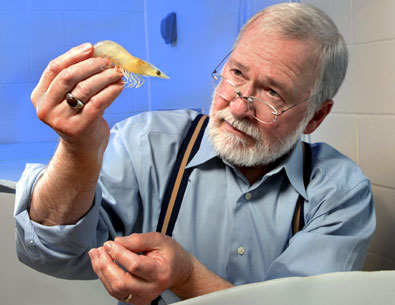Inside Iowa State
Inside ArchivesSubmit newsSend news for Inside to inside@iastate.edu, or call (515) 294-7065. See publication dates, deadlines. About InsideInside Iowa State, a newspaper for faculty and staff, is published by the Office of University Relations. |
April 18, 2008 
Hank Harris' study of infectious diseases has included the traditional Iowa pig and the not-so-traditional Iowa shrimp. Photo by Bob Elbert. Taking down infectious diseasesby Barbara McBreen, Agriculture and Life Sciences Communications After unlocking two security doors, Hank Harris walks down a hallway in Kildee Hall to a room with six tanks full of salt water. The tanks look like giant ice cream pails about four feet high and three feet across. Each holds shrimp of varying ages. Harris, a professor of animal science and veterinary diagnostic and production animal medicine, gently reaches in one tank and pulls up a shrimp more than six inches long, a large size for a shrimp in captivity. "It's more difficult to raise the larger shrimp in ponds or farms because of infectious diseases," Harris said. "That's why larger shrimp are more expensive." The translucent crustaceans have multiple legs, two antennae and compound eyes that seem to hang on each side of a skeletal head. While Harris holds one shrimp, another occasionally jumps out of the water, trying to escape. Shrimp live four to five months and can weigh up to 30 grams. Harris orders about 4,000 larvae shrimp every three months to restock the tanks. Shrimp research in IowaHarris began studying infectious diseases in shrimp in 2002. He started thinking about shrimp research in the 1990s when scientists from the Oceanic Institute in Hawaii contacted him. They asked about his work with pigs and realized they could apply those methods to shrimp. "There are some interesting bacterial diseases in shrimp and there wasn't much research being done at the time," Harris said. Shrimp are difficult to grow in captivity because of disease, Harris said. About half the shrimp consumed in the United States are farmed in ponds along coastal North and South America and Asia. Harris said there wasn't much interest in shrimp research in Iowa until ethanol production started. "The ethanol folks wanted to know if the byproducts from ethanol production could be used as a food source for shrimp," Harris said. Harris received a $40,000 grant from Midwest Grain for the research. He also has received funding from an Indonesian company, which supplies 10 percent of the world's farmed-shrimp market, to study infectious diseases and food sources. Harris said the shrimp research also offers an excellent model for training students in infectious disease work. "It's not expensive and you can do a lot of replication for statistical analysis," Harris said. The leap from pigs to shrimpHarris has studied infectious diseases for 40 years. During that time, he and his colleagues have made multiple discoveries that benefited the pork industry. In 2005, Harris was included in the National Hog Farmer magazine's top 50 men and women who have made a difference in the pork industry. But what are the similarities between pigs and shrimp? "The lab procedures are almost identical for pigs or humans or shrimp. The similarities are in disease control. Like pigs, we begin by eliminating the pathogens that cause disease. And, like pigs, we separate the shrimp by age," Harris said. A solution for hog dysenteryHarris has a long list of accomplishments and awards, but one memento hanging in his office draws attention -- a pencil drawing of a bacterium, which appears to be wormlike. The drawing represents a discovery Harris and his colleagues made in the early 1970s at Iowa State. The group unearthed a microscopic bacterium that caused swine dysentery, a disease that was taking its toll on the pork industry. In 2005, another discovery helped Harris again fight a disease taxing the pork industry. Harris and Matt Erdman, a doctoral student, developed a vaccine to prevent Porcine Reproductive Respiratory Syndrome (PRRS). The virus, which was discovered in the late 1980s, causes infertility and reproductive problems in pigs. Harris and Erdman started a company called Sirrah (Harris spelled backward) to develop and distribute the vaccine. Currently, there are two other vaccines on the market. One uses a modified live virus and the other uses an inactivated virus, but both use the whole virus to prepare the vaccine. "We are hoping that our vaccine is an improvement over current vaccines," Harris said. "Instead of the whole virus, we use a replicon and this appears to give us more protein from the protective component of the virus than the other two vaccines." Another Harris discovery benefiting the pork industry focused on isolating piglets after weaning. The idea formed the basis for multiple-site production, which is the industry standard today. "I think the most interesting thing to me was how simple it was to eliminate disease by removing piglets from the environment where they were born and placing them in an isolated location," Harris said. "Multiple-site production is standard today. The technique eliminated diseases and allowed pigs to grow more rapidly and efficiently." Harris has been studying infectious diseases since 1967 and is amazed how diseases continue to evolve and change. "Twenty years ago, the World Health Organization believed infectious diseases would be conquered," Harris said. "Infectious diseases continue to be a problem and it appears they will keep evolving. "There are more types of diseases we have to contend with, and it's probably due to increases in population, how we travel and how we move and raise animals around the world," he said. "All those factors contribute to infectious diseases." |
Quote"There are more types of diseases we have to contend with, and it's probably due to increases in population, how we travel and how we move and raise animals around the world." Hank Harris |